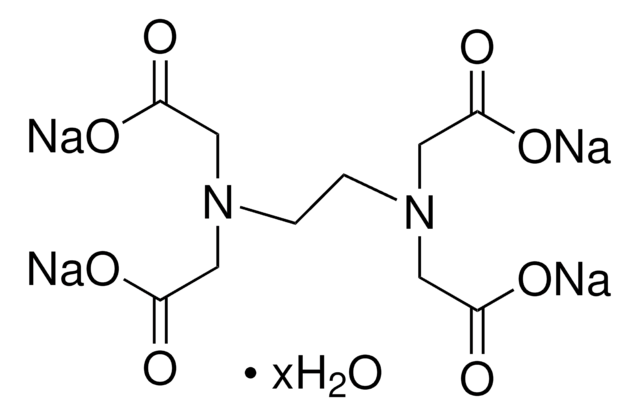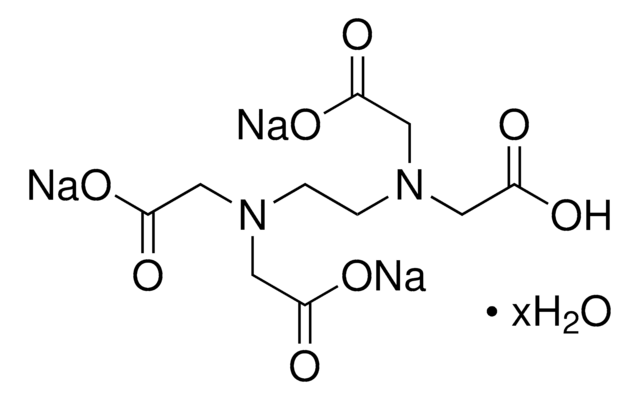ED4SS
Ethylenediaminetetraacetic acid tetrasodium salt dihydrate
99.0-102.0% (titration)
Synonyme(s) :
EDTA tetrasodium salt, Edathamil, Tetrasodium ethylenediaminetetraacetate dihydrate
About This Item
Produits recommandés
Niveau de qualité
Essai
99.0-102.0% (titration)
Forme
crystalline
Pertinence de la réaction
reagent type: chelator
Solubilité
H2O: soluble, clear, colorless
Chaîne SMILES
O.O.[Na+].[Na+].[Na+].[Na+].[O-]C(=O)CN(CCN(CC([O-])=O)CC([O-])=O)CC([O-])=O
InChI
1S/C10H16N2O8.4Na.2H2O/c13-7(14)3-11(4-8(15)16)1-2-12(5-9(17)18)6-10(19)20;;;;;;/h1-6H2,(H,13,14)(H,15,16)(H,17,18)(H,19,20);;;;;2*1H2/q;4*+1;;/p-4
Clé InChI
KSYNLCYTMRMCGG-UHFFFAOYSA-J
Vous recherchez des produits similaires ? Visite Guide de comparaison des produits
Description générale
Application
- in the decalcification of femurs for the histoprocessing and staining of osteochondral tissue
- as a component of NH4Cl lysis buffer for erythrocyte lysis and bulk characterization
- for the isolation of crypts from the connective tissues of mice
Actions biochimiques/physiologiques
Produit(s) apparenté(s)
Mention d'avertissement
Danger
Mentions de danger
Conseils de prudence
Classification des risques
Acute Tox. 4 Inhalation - Acute Tox. 4 Oral - Eye Dam. 1 - STOT RE 2
Organes cibles
Respiratory Tract
Code de la classe de stockage
11 - Combustible Solids
Classe de danger pour l'eau (WGK)
WGK 2
Point d'éclair (°F)
Not applicable
Point d'éclair (°C)
Not applicable
Équipement de protection individuelle
dust mask type N95 (US), Eyeshields, Gloves
Faites votre choix parmi les versions les plus récentes :
Déjà en possession de ce produit ?
Retrouvez la documentation relative aux produits que vous avez récemment achetés dans la Bibliothèque de documents.
Les clients ont également consulté
Articles
This procedure applies to all products that have a specification for Cathepsin B activity determined by the liberation of 7-amino-4-methylcoumarin from Z-Arg-Arg 7-amido-4-methylcoumarin.
Protocoles
Objective: To standardize a procedure for the recycling micro-assay of β-NAD and β-NADH
Enzymatic Assay of α-Glucosidase by the Modified Boehenger Procedure (EC 3.2.1.20)
Enzymatic assay of lipase type XIII from Pseudomonas sp. using a coupled enzyme system of glycerol kinase and glycerophosphate oxidase (EC 3.1.1.3)
This procedure may be used for all Ficin products.
Notre équipe de scientifiques dispose d'une expérience dans tous les secteurs de la recherche, notamment en sciences de la vie, science des matériaux, synthèse chimique, chromatographie, analyse et dans de nombreux autres domaines..
Contacter notre Service technique









